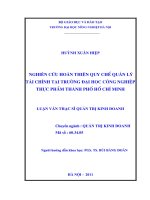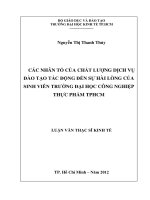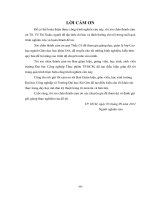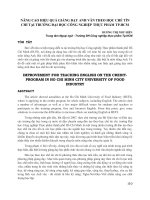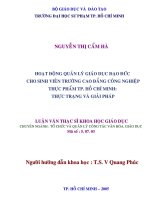ICELT distance - Unit 5: Grammar presentation & practice - Trường Đại học Công nghiệp Thực phẩm Tp. Hồ Chí Minh
Bạn đang xem bản rút gọn của tài liệu. Xem và tải ngay bản đầy đủ của tài liệu tại đây (80.67 KB, 10 trang )
<span class='text_page_counter'>(1)</span><div class='page_container' data-page=1></div>
<span class='text_page_counter'>(2)</span><div class='page_container' data-page=2>
ICELT distance unit 5 Grammar presentation & practice
<b>Contents </b>
Introduction ……… 3
Aims ……….. 3
Reading ……… 4
Section A – Reflection ………. 5
Section B – Approaches to teaching grammar ……… 8
Section C – Presentation techniques ……….. 19
Section D – Practice techniques ……….. 29
Section E – Grammar in the young earner classroom ………… 34
References ……… 35
Feedback on unit ………. 36
</div>
<span class='text_page_counter'>(3)</span><div class='page_container' data-page=3>
ICELT distance unit 5 Grammar presentation & practice
<b>Introduction </b>
In many traditional language classrooms, grammar was viewed as the most
important aspect of language learning. Methodology was concerned almost
solely with ways of having learners practise the grammar with vocabulary and
pronunciation slotted in. Nowadays most teachers would not recognise that
situation – there has been a growing acceptance that there is much more to a
language than grammar. In the 1970’s, the communicative approach mostly
abandoned this emphasis on grammatical form in favour communicating the
message successfully, despite inaccuracies. More recently, however, the
importance of focussing on form has been addressed again.
In this unit we will be considering different approaches to teaching grammar and
whether we need to make form (or structure) rules explicit to learners. We shall
evaluate a number of presentation and practice techniques.
<b>Aims </b>
By the end of this unit you should:
• Have a clearer understanding of deductive, inductive and guided discovery
approaches to grammar teaching
• Have analysed lessons in relation to these approaches
• Have analysed the learning process within a guided discovery lesson
• Have planned a sequence of activities using a guided discovery
framework
• Have evaluated a number of presentation techniques
• Have a clearer understanding or the notion of controlled and free practice
activities
• Have planned controlled and free practice activities for particular language
points
• Have considered the place of grammar in younger learner classrooms
</div>
<span class='text_page_counter'>(4)</span><div class='page_container' data-page=4>
ICELT distance unit 5 Grammar presentation & practice
<b>Essential Reading</b>
Cameron, L. 2001 <b>Teaching Languages to Young Learners.</b> CUP
Chapter 5 – Learning Grammar
Nunan, D. 1991 <b>Language Teaching Methodology</b>. Longman
Chapter 8 – the Role of Grammar
Ur, P. 1999 <b>A Course in Language Teaching: Practice and Theory</b> CUP
<b>Recommended Further Reading </b>
ELT Forum Teacher Development Pack: Grammar
</div>
<span class='text_page_counter'>(5)</span><div class='page_container' data-page=5>
ICELT distance unit 5 Grammar presentation & practice
Section A: Reflection
<b>Task 1 </b>
Read the following comments which were made by different teachers. Consider
whether you agree or disagree with them and why. If possible, do this task with a
colleague.
1. I usually tell the students the rule before we practice grammar.
2. I try not to use grammar terminology in the classroom.
3. I like to use examples from my students’ life when I am teaching grammar.
4. I think if we provide enough good examples, then students can infer the
rules without being told.
5. It is easy to explain some grammar rules by others are so complicated that
it is better not to bother.
6. It is better to do other activities such as reading a story or listening to a
song first that lead to grammar.
When you have finished, look at the commentary that follows.
</div>
<span class='text_page_counter'>(6)</span><div class='page_container' data-page=6>
ICELT distance unit 5 Grammar presentation & practice
Commentary
1. I usually tell the students the rule before we practice grammar.
This is one of the features of the deductive approach (don’t be confused by the
name!) to grammar teaching. In this approach the teacher moves from rules to
examples. In contrast, there is the inductive approach, in which learners are
presented with lots of examples and they work out the rule for themselves; in
other words they induce the rule.
This is also very characteristic of the grammar translation method of language
teaching and is also very common in students’ grammar books.
2. I try not to use grammar terminology in the classroom.
If you are teaching very young learners you probably agreed with this.
If you are teaching older children or adults then it is very difficult to avoid
terminology altogether unless you are using a totally experiential approach to
language learning where the students are using the language to perform task
with no explicit analysis of the language.
On the other hand, over use of terminology with turn a lot of students off and it is
important to be sensitive to the effect use of terminology is having on students.
3. I like to use examples from my students’ life when I am teaching grammar.
This attitude comes from a humanistic approach to language learning in which it
is believed that affective (emotional) factors as just as important as cognitive
factors.
It is probably an obvious point but if learning is personalised in this way then it
will probably be more memorable. Traditionally, the personalisation stage comes
after the presentation but there is no reason why the presentation itself should
not be personalised. However, this would require a great deal of skill on the
teacher’s part.
4. I think if we provide enough good examples, then students can infer the rules
without being told.
See number 1. This is characteristic of an inductive approach to learning
grammar. This approach is also called a discovery approach. It is comparable to
the way in which we learn our first language; direct experience of the language
and unconscious assimilation of rules.
</div>
<span class='text_page_counter'>(7)</span><div class='page_container' data-page=7>
ICELT distance unit 5 Grammar presentation & practice
5. It is easy to explain some grammar rules by others are so complicated that
it is better not to bother.
Most experienced teacher would accept this and plan their teaching
accordingly. Perhaps a more important point is that some rules are very
difficult to induce or discover. For example the correct placement of adverbs
– I like football very much or He is often late may never be noticed by
students unless they are pointed out explicitly.
6 It is better to do other activities such as reading a story or listening to a
song first that lead to grammar.
This is an underlying principle in such approaches as task-based learning and
the whole language approach – you learn best by doing.
</div>
<span class='text_page_counter'>(8)</span><div class='page_container' data-page=8>
ICELT distance unit 5 Grammar presentation & practice
Section B: Approaches
The tasks in this section have been taken from Thornbury, 2004)
<b>Task 1</b>
Read through the following three mini lessons and for each one decide:
• Sequence: Which comes first the rule or the example?
• Rule: Is the rule stated explicitly or is it implicitly understood?
• Guidance: How much does the teacher guide the learners?
<b>____________________ </b>
<b>Lesson 1 </b>
Teacher
“to form the present perfect continuous, use the auxiliary verb have plus the
past participle of the verb to be (been) plus the present participle, for example
…”
Teacher writes on the board:
I have been working.
Has Jeff been watching TV?
They haven’t been listening.
“You use the present perfect continuous to talk about activities that started in
the past and continue to the present (or very recent past), especially when
you want to focus on the process itself, or its duration, for example…”
Teacher writes on board:
We have been living here since we got married.
How long have you been studying Chinese?
Why is your hair wet? I’ve been swimming.
“Now make sentences using the present perfect continuous for these
situations…
Jeff started watching TV at five o’clock. Hi has just switched the TV off. It is
now nine o’clock.
I first came to live in this town five years ago. I’m still living here.
Our company was set up over 100 years ago. We manufactured bicycles
them and we are still manufacturing them.”
</div>
<span class='text_page_counter'>(9)</span><div class='page_container' data-page=9>
ICELT distance unit 5 Grammar presentation & practice
_____________________
<b>Lesson 2 </b>
Teacher:
“Dawn is standing outside the cinema. She is waiting for her friend. Dawn
arrived at eight o’clock. It’s now ten past eight. She has been waiting for ten
minutes.
When did she start waiting?
(Learners: “Eight o’clock.”)
Is she still waiting?
(Learners: “Yes.”)
How do you express the idea of waiting that started in the past and is still
continuing?
(Learners: “She has been waiting.”)
How is the tense formed?
(Learners: “Have plus been plus –ing.”)
This tense is called the present perfect continuous.
Here is another situation:
It is now nine o’clock and Jeff is watching TV. He started watching TV at five
o’clock . He has been watching TV for four hours.
Use the present perfect continuous to make a sentence for each of these
situations:
I first came to live in this town five years ago. I’m still living here.
Our company was set up over 100 years ago. We manufactured bicycles
then, and we are still manufacturing them.”
_________________________
</div>
<span class='text_page_counter'>(10)</span><div class='page_container' data-page=10>
ICELT distance unit 5 Grammar presentation & practice
<b>Lesson 3 </b>
Teacher:
“Once upon a time, Goldilocks visited the Bears’ house. There was nobody
home. She ate some of Baby Bear’s porridge. She smoked one of Father
Bear’s cigars. She drank some of Mother Bear’s coffee, and she rode Mother
Bear’s motorbike. She played with Buddy Bear’s toys, and she played Buddy
Bear’s guitar. She read some of Missy Bear’s magazines, and she used
Missy Bear’s computer.
Well, finally, she felt tired so she went upstairs to sleep. When the Bears
came home, Baby Bear said, “Who’s been eating my porridge?” Repeat.
(Learners: “Who’s been eating my porridge?”)
Mother Bear said, “Who’s been drinking my coffee?” Repeat.
(Learners: “Who’s been drinking my coffee?”)
Father Bear said, “Who’s been smoking my cigar?” Repeat.
(Learners: “Who’s been smoking my cigar?”
What did Missy Bear say about her magazines?
(Learners: Who’s been reading my magazines?”
And her computer?
(Learners: “Who’s been using my computer?”
What did Buddy Bear say about his toys?
(Learners: “Who’s been playing with my toys?”
And his guitar?
(Learners: “Who’s been playing my guitar?”
What did Mother Bear say about her motorbike?
(Learners: “Who’s been riding my motorbike?”
Now tell the story to your partner.”
<b> ________________________ </b>
</div>
<!--links-->

